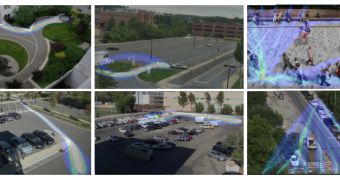Surveillance and Security is one of the industrial fields that could leap ahead of the rest in the relatively near future, although some people might not appreciate the direction proposed by researchers at Carnegie Mellon University.
With funding from the US government, a team of scientists has created the so-called automatic video surveillance technology.
The basic idea behind it is that future security cameras could use certain algorithms and incoming visual data to “guess” what people within the field of view are about to do.
The technology is similar to the one used in Google's self-driving cars and makes liberal use of face recognition software.
“Cognitive engine” is what the software is currently known as. The “nouns” it can understand are people and objects, while the “verbs” are actions the nouns are allowed to do. Activity forecasting is done based on these parameters.
Practically every video surveillance systems of today could benefit from something like this, even though implementation will cut the number of human jobs available.
At present, one or more members of a venue's surveillance staff need to be in the control room at all times, and keep vigilance over the many screens there. The “cognitive engine” could make human presence unnecessary and will not be subject to the decline in attention span that humans inevitably fall prey to. Human multitasking won't be an issue either.
The Carnegie Mellon University team sees their technology being used in places like airports, stores, driveways, parking lots, city centers, etc. Military bases and high-profile government buildings could benefit just as much, if not more.
Currently, the “prediction” capabilities are limited to calculating the likeliest trajectories that humans or cars might take. The software “models the effect of the physical environment on the choice of human actions.”
Future versions of the technology should be capable of taking into account a broader range of triggers and estimate more complex actions.

 14 DAY TRIAL //
14 DAY TRIAL //